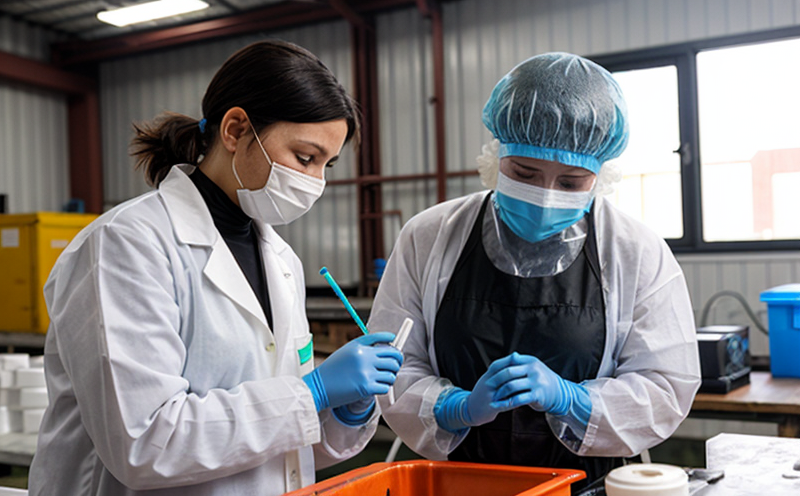ISO 13320 Particle Size Distribution in Recycled Nanocomposite Powders
The ISO 13320 standard provides a method to determine the particle size distribution of powders, which is essential for understanding and optimizing the properties of recycled nanomaterials. This service involves characterizing the size distribution of these materials using laser diffraction techniques. The precision of this analysis is critical for ensuring that recycled nanocomposites meet both quality standards and performance expectations.
Recycled nanomaterials are increasingly important in sustainable manufacturing, as they contribute to reducing waste and resource consumption. However, their effective use requires a thorough understanding of the particle size distribution. This test helps manufacturers ensure consistent product quality by providing insights into how different particle sizes behave during processing and final application.
The ISO 13320 method is particularly useful for materials like carbon nanotubes, graphene, and other nanocomposites that are used in composites, coatings, and electronics. By determining the particle size distribution, we can better control the dispersion of these nanomaterials within the matrix material, which ultimately influences the mechanical, electrical, thermal, and chemical properties.
The laser diffraction technique employed ensures high accuracy and reproducibility. This method measures light scattered by particles suspended in a fluid medium as it passes through an optical system. The intensity distribution of this scattered light provides information about the particle size distribution.
For quality managers and compliance officers, understanding the particle size distribution is crucial for ensuring that recycled nanomaterials meet regulatory standards and customer specifications. R&D engineers can use these data to optimize product formulations and improve performance characteristics. For procurement teams, knowing the particle size distribution helps in selecting suppliers who can provide materials meeting specific requirements.
The test involves several steps: specimen preparation, calibration of the instrument, measurement, data analysis, and reporting. Specimen preparation includes dispersing the nanomaterials into a suitable medium to ensure uniformity and prevent agglomeration. Calibration ensures that the instrument accurately measures particle sizes. The measurement process involves passing the dispersed sample through the laser diffraction system, where the scattered light is captured and analyzed.
After collecting data, statistical analysis techniques are applied to interpret the results. Reporting includes presenting the particle size distribution in various graphical formats such as histograms or cumulative distribution curves. This information is valuable for stakeholders involved in quality assurance, product development, and supply chain management.
Why It Matters
The importance of particle size distribution testing cannot be overstated when dealing with recycled nanocomposite powders. The properties of these materials are highly sensitive to the size and shape of their constituent particles. For instance, in composite applications, smaller particles generally provide better mechanical strength due to increased interfacial area between the matrix and filler.
However, excessively small particles can lead to agglomeration or clogging during processing, while very large particles may not disperse effectively within the matrix material. Understanding these nuances through ISO 13320 testing allows for precise control over the manufacturing process, resulting in higher quality products and more efficient use of resources.
From an environmental perspective, optimizing particle size distribution can reduce energy consumption during processing and improve recycling rates by making it easier to separate and reprocess materials. This aligns with broader sustainability goals within industries like electronics, automotive, and construction.
Furthermore, regulatory compliance becomes more straightforward when precise data on particle size distribution is available. Compliance officers can use these results to demonstrate adherence to international standards such as ISO 13320 and ensure that products meet the necessary safety and performance criteria.
Eurolab Advantages
At Eurolab, we offer unparalleled expertise in nanomaterials testing using ISO 13320 methods. Our state-of-the-art laboratory facilities equipped with advanced laser diffraction instruments ensure accurate and reliable results. Our team of experienced scientists brings deep knowledge of both the technical aspects of particle size distribution analysis and its broader implications for material science.
We pride ourselves on providing comprehensive support throughout the testing process, from initial consultation to final report delivery. This includes offering guidance on specimen preparation, interpreting results, and leveraging data for decision-making purposes. Our commitment to quality is reflected in our adherence to international standards and continuous improvement practices within our laboratory operations.
Our reputation as a leading provider of nanomaterials testing services is built on delivering accurate, reproducible results that meet or exceed client expectations. Whether you're developing new products or ensuring compliance with existing regulations, Eurolab can help you achieve your goals through precise ISO 13320 particle size distribution analysis.
Use Cases and Application Examples
| Application Example | Description |
|---|---|
| Electronics Manufacturing | Ensuring optimal particle size for efficient dispersion in advanced electronic components. |
| Aerospace Composites | Optimizing the mechanical properties of recycled nanocomposites used in aircraft structures. |
| Bio-Compatible Coatings | Guaranteeing precise particle size for enhanced biocompatibility and performance. |
- Electronics Manufacturing: Ensuring optimal particle size for efficient dispersion in advanced electronic components.
- Aerospace Composites: Optimizing the mechanical properties of recycled nanocomposites used in aircraft structures.
- Bio-Compatible Coatings: Guaranteeing precise particle size for enhanced biocompatibility and performance.





